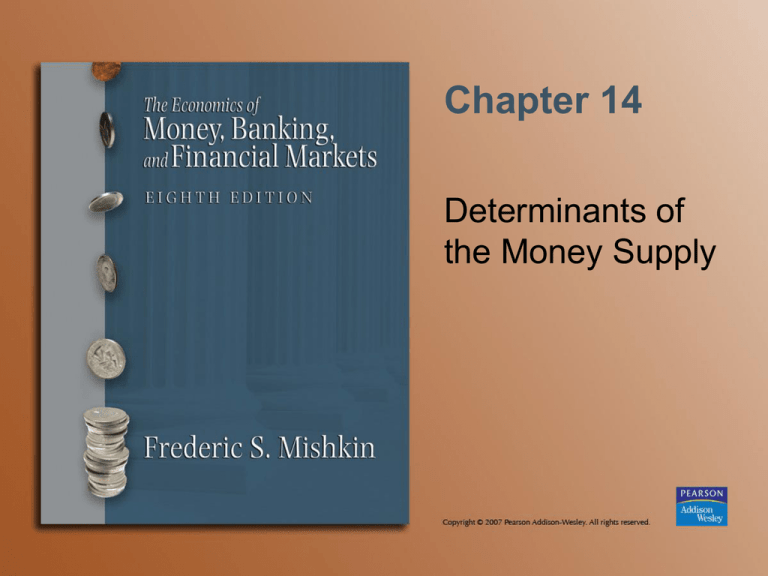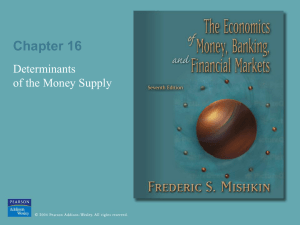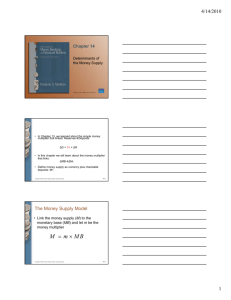
Chapter 14
Determinants of
the Money Supply
The Money Supply Model
• Define money as currency plus
checkable deposits: M1
• The Fed can control the monetary base
better than it can control reserves
• Link the money supply (M) to the
monetary base (MB) and let m be the
money multiplier
M m MB
Copyright © 2007 Pearson Addison-Wesley. All rights reserved.
14-2
Deriving the Money Multiplier I
Assume the desired level of currency C and excess reserves ER
grows proportionally with checkable deposits D
Then
c = {C / D} = currency ratio
e = {ER / D} = excess reserves ratio
Copyright © 2007 Pearson Addison-Wesley. All rights reserved.
14-3
Deriving the Money Multiplier II
The total amount of reserves (R) equals the sum of
required reserves (RR) and excess reserves (ER).
R = RR + ER
The total amount of required reserves equals the required
reserve ratio times the amount of checkable deposits
RR = r × D
Subsituting for RR in the first equation
R = (r × D) + ER
The Fed sets r to less than 1
Copyright © 2007 Pearson Addison-Wesley. All rights reserved.
14-4
Deriving the Money Multiplier III
The monetary base MB equals currency (C) plus reserves (R)
MB = R + C = (r D) + ER + C
Reveals the amount of the monetary base needed to support
the existing amounts of checkable deposits, currency, and
excess reserves.
An increase in the monetary base that goes into currency is
not multiplied, whereas an increase that goes into supporting
deposits is multiplied.
An additional dollar of MB that goes into excess reserves ER
does not support any additional deposits or currency
Copyright © 2007 Pearson Addison-Wesley. All rights reserved.
14-5
Deriving the Money Multiplier IV
c = {C / D} C = c D and
e = {ER / D} ER = e D
Substituting in the previous equation
MB (r D) (e D) (c D) (r e c) D
Divide both sides by the term in parentheses
1
D
MB
r ec
M D C and C c D
M D (c D) (1 c) D
Substituting again
1 c
M
MB
r ec
The money multiplier is then
1 c
m
r ec
Copyright © 2007 Pearson Addison-Wesley. All rights reserved.
14-6
Intuition Behind the Money Multiplier
r required reserve ratio = 0.10
C currency in circulation = $400B
D checkable deposits = $800B
ER excess reserves = $0.8B
M money supply (M1) = C D = $1,200B
$400B
0.5
$800B
$0.8B
e
0.001
$800B
1 0.5
1.5
m
2.5
0.1 0.001 0.5 0.601
This is less than the simple deposit multiplier
c
Although there is multiple expansion of deposits,
there is no such expansion for currency
Copyright © 2007 Pearson Addison-Wesley. All rights reserved.
14-7
Factors that Determine
the Money Multiplier
• Changes in the required reserve ratio r
The money multiplier and the money supply are
negatively related to r
• Changes in the currency ratio c
The money multiplier and the money supply are
negatively related to c
• Changes in the excess reserves ratio e
The money multiplier and the money supply are
negatively related to the excess reserves ratio e
Copyright © 2007 Pearson Addison-Wesley. All rights reserved.
14-8
Factors that Determine
the Money Multiplier (cont’d)
• The excess reserves ratio e is negatively
related to the market interest rate
• The excess reserves ratio e is positively
related to expected deposit outflows
Copyright © 2007 Pearson Addison-Wesley. All rights reserved.
14-9
Copyright © 2007 Pearson Addison-Wesley. All rights reserved.
14-10
Additional Factors
• Open market operations are controlled
by the Fed
• The Fed cannot determine the amount of
borrowing by banks from the Fed
• Split the monetary base into two components
MBn= MB - BR M = m(MBn + BR)
• The money supply is positively related to both
the non-borrowed monetary base MBn and
to the level of borrowed reserves, BR, from
the Fed
Copyright © 2007 Pearson Addison-Wesley. All rights reserved.
14-11
Copyright © 2007 Pearson Addison-Wesley. All rights reserved.
14-12
Copyright © 2007 Pearson Addison-Wesley. All rights reserved.
14-13
Explaining Movements
in the Money Supply
• Over long periods, the primary
determinant of movements in the money
supply is the nonborrowed monetary
base, which is controlled by the Fed’s
open market operations
Copyright © 2007 Pearson Addison-Wesley. All rights reserved.
14-15
Copyright © 2007 Pearson Addison-Wesley. All rights reserved.
14-16
Copyright © 2007 Pearson Addison-Wesley. All rights reserved.
14-17
Copyright © 2007 Pearson Addison-Wesley. All rights reserved.
14-18








